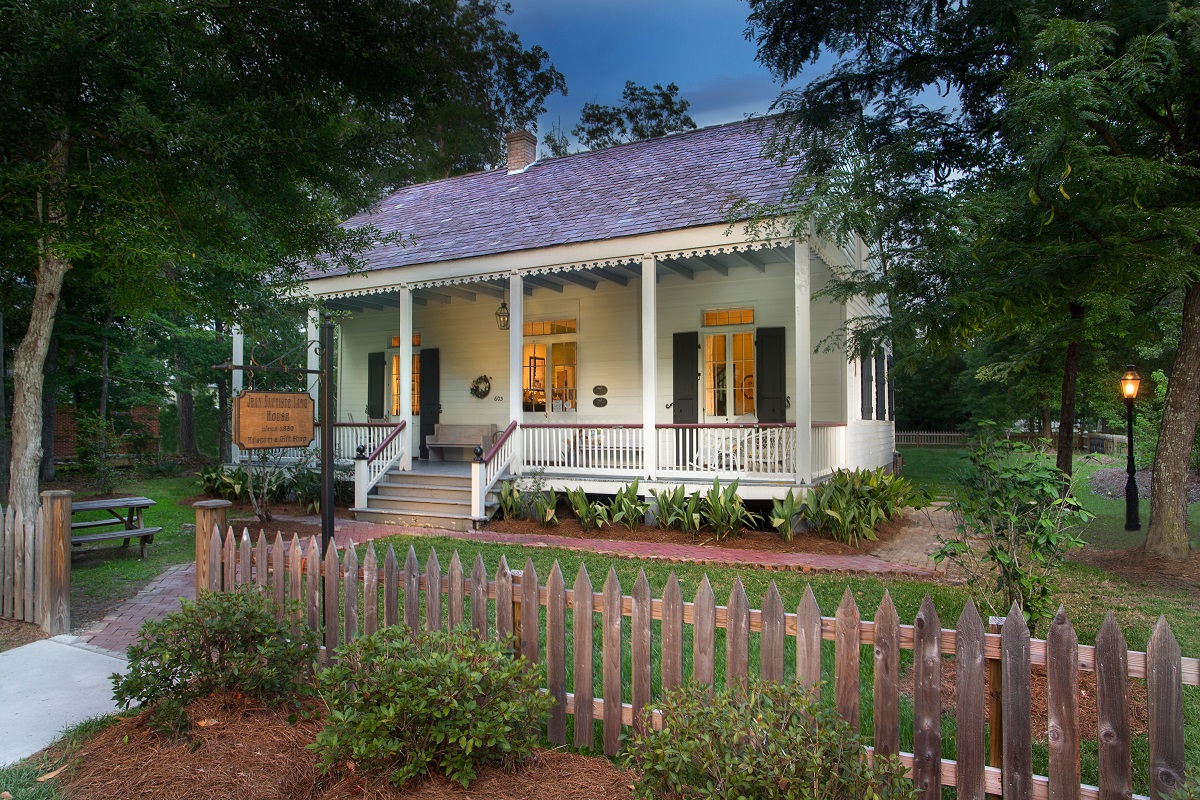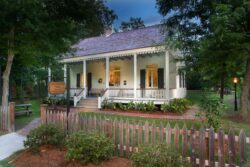The Lang House
A resurrected Anglo-Creole fixture in Mandeville
Published: November 30, 2020
Last Updated: June 1, 2023

Photo by Chad Chenier
But for the Fosters—she’s a retired history teacher and he’s an engineer—that passionate sense of stewardship has borne tangible fruit beyond just their own abode. Two of the founding members of the Old Mandeville Historic Association, established in 2009, the Fosters and their colleagues worked with the town’s present mayor, Donald Villere, to establish a downtown historic district, now sporting more than ninety historic plaques. “We couldn’t believe Mandeville didn’t have any preservation policies. It was just shocking,” she recalled. When Foster saw six old houses razed in that first year after their move to the Northshore, she knew something had to be done. “I thought, my gosh, there’s not going to be anything left!”
The district’s crown jewel is the restored 168-year-old Lang House on Carroll Street, which opened in 2014 as a museum and educational center. The Anglo-Creole cottage offers a portal into the late nineteenth century, when well-to-do families from New Orleans crossed the lake to escape the heat and yellow fever that affected the city. “Houses along the lakefront were essentially high-end camps,” Foster said. “They were designed with plenty of sleeping room so that large families and extended families could vacation here.”
The Lang House is one such home, built in 1852 by Jean Baptiste Lang, a divorced tobacco merchant from Luxembourg who had migrated to New Orleans in the 1830s. The house was sold at auction after his death in 1866; the original of the advertisement for the sale is with The Historic New Orleans Collection, with a framed copy on display at the house. Among the various owners, Jules Zatarain and his family were likely the first residents to live year-round in Mandeville. His son Emile founded the Zatarain’s spice and food product company in the late 1890s.
The Lang House was flooded and wrecked by Hurricane Katrina. Owner Will Jourdan wanted to deed it to the city in 2011, which caused lots of wrangling with Mandeville’s city council. Although it was “free,” the house had to be moved six blocks from its original location on the lakefront to the donated Kierr Gardens site at 605 Carroll Street for about $150,000. “We got it done,” said Foster, one of the project’s biggest cheerleaders.
The museum was closed by the pandemic, but Foster hopes to reopen the house for tours in September. She still is onsite often, usually sitting on the front porch, happy to share her deep knowledge of the Lang House with visitors. The original building had a “cave” or wine cellar under the raised privy stairs, a bath house and wharf, slave quarters, kitchen house, stables, cistern, bead board, slate roof, and a double chimney. The restored house is rich with architectural features such as the faux bois oak finish—a method of painting that mimics wood grain—hidden under layers of paint. Mortise-and-tenon construction, where all wood joints were designed to fit together, tongue-and-groove floors, scarf joints—these details speak to a care for craftsmanship and materials rare in today’s world. Foster, the house museum’s director, credits the work of local master carpenter Robert Reimonenq for critical and authentic architectural and furniture restoration.
“This house is one of the few Anglo-Creole structures left standing in Old Mandeville,” she said. “I’m still surprised by how many locals don’t know the architectural riches we have here and what they can teach us about history. I hope we’re back in business telling that story soon.”
Beth D’Addono is a food and travel writer based in New Orleans.
